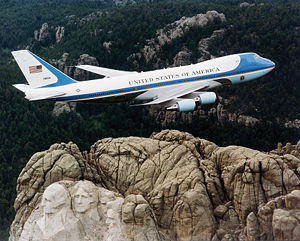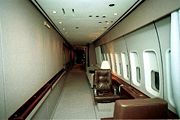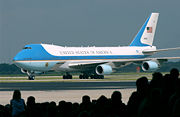Boeing VC-25
| VC-25 "Air Force One" | |
|---|---|
 |
|
| Air Force One over Mount Rushmore. | |
| Role | Presidential transport |
| Manufacturer | Boeing |
| Introduced | 23 August 1990 (No. 28000) 23 December 1990 (No. 29000) |
| Status | Active service |
| Primary user | United States Air Force |
| Produced | 1987 |
| Number built | 2 |
| Unit cost | US$ 325 million |
| Developed from | Boeing 747 |
| Variants | Boeing E-4 |
The Boeing VC-25 is the designation of a United States Air Force passenger transportation aircraft, a military version of the Boeing 747.
The VC-25 is most famous for its role as Air Force One, the callsign of any U.S. Air Force aircraft carrying the President of the United States. The two aircraft currently in U.S. service are highly modified versions of Boeing's 747-200B, with tail numbers 28000 and 29000. Although the Air Force One designation technically applies to the planes only while the President is aboard, the term is commonly applied to the VC-25As more generally. They often operate in conjunction with Marine One, the helicopter which ferries the President to airports in circumstances where a vehicle motorcade would be inappropriate.
Contents |
Development
The fabrication of the current 747s began during the presidency of Ronald Reagan (1981–1989). Reagan ordered two identical Boeing 747s to replace the 707 that he used for transport.[1] The interior designs were created by First Lady Nancy Reagan, who used designs reminiscent of the American Southwest.[1] The first aircraft was delivered in 1990, during the administration of George H.W. Bush. Delays were experienced to allow for additional work to protect the aircraft from electromagnetic pulse (EMP).
Design and configuration
While the VC-25 has three levels, like a regular Boeing 747, its 4,000 square feet (370 m²) of floor space has been reconfigured for presidential duties. Its lowest levels are mostly cargo space, carrying luggage and the onboard food supply.
The main passenger area is on the second floor.[2] There are three entrances onboard, two on the lower and one on the main deck. Typically the president boards and deplanes from the front, main deck entrance via an airstair, while journalists and other passengers enter at the lower rear door. Facilities for the press and other passengers are configured like an ordinary airliner's first-class cabin.[3]
"The White House"




The bow (front) of the aircraft is referred to as the "White House" of the plane.[2] The president's executive suite includes sleeping quarters with two couches that can be converted into beds, lavatory and full-ranged shower, vanity, double sink, and a private office, or the president’s "Oval Office aboard Air Force One".[2] If necessary, the president can address the nation from the office. These offices, including the president's suite, are mostly located on the starboard (right), and a long corridor runs along the port (left) side.[2] There is an area along the corridor for two Secret Service agents.[2] The plane also contains a conference room, originally designed as situation room but now used for meeting with staff while traveling.[2] This room includes a 50 inch plasma screen television which can be used for teleconferencing.[2] The planes have fully equipped office areas with telecommunication systems (including 87 telephones[2] and 19 televisions).
On board the VC-25 is a medical annex, which includes a fold-out operating table, emergency medical supplies, and a well-stocked pharmacy;[2] President George W. Bush had a treadmill added to Air Force One during his term in office. Every flight is staffed by a doctor and nurse.[2] Chief Flight Attendant Reggie Dixon said, "Air Force One will leave Andrews Air Force Base self-contained," meaning that no matter how long the trip, the plane leaves with all the food it will need.[2] Meals are prepared in two galleys, which together are equipped to feed up to 100 people at a time.[2] The President gets his own menu.[2]
Near the center of the plane, outside of what is referred to as "the White House", is an area where guests sit. In recent years, it has also been used to transport deceased former presidents. The chairs and tables are able to be removed and the casket laid in their place.[2] Colonel Mark Tillman, pilot for President George W. Bush, said, "We’ll take care of the president from basically when he’s in office to when he lays in state. Air Force One will take care of the president."[2] For the funeral of President Ronald Reagan in 2004, Tillman said that the crew converted the front of the aircraft to look the way it would have appeared when Reagan was president; President and Nancy Reagan’s Air Force One jackets were placed on the chairs to “make them at home”.[2]
There are separate quarters for guests, senior staff, Secret Service and security personnel, and the news media located in the aft (back) of the second floor.[2] Protocol is wherever your assigned seat is, you can go aft of your seat but not forward.[2] Communications equipment and the cockpit are on the third floor.[2] There are also secure and non-secure voice, fax and data communications facilities.
While the plane's luggage capacity is adequate to carry the belongings of the passengers, the logistics train of the President means that the plane must fly preceded by an aerial convoy of several cargo transports, which carry the helicopters, motorcade vehicles, and other equipment required by the presidential entourage.[2]
The VC-25A is capable of flying 7,800 miles (12,600 km)—roughly one-third the distance around the world—without refueling and can accommodate more than 70 passengers. Each VC-25A cost approximately US$325 million. When Air Force One taxis to an airport's ramp for events, it comes to a stop with the port side of the aircraft facing gathered onlookers.
Operational history
The VC-25s replaced the VC-137C (a military version of the Boeing 707) as the mainstays of the Air Force One fleet. On some occasions, the VC-25s are used to transport the Vice President of the United States, for which service they adopt the callsign Air Force Two. These aircraft are maintained and operated as military operations by the Presidential Airlift Group, part of Air Mobility Command's 89th Airlift Wing, based at Andrews Air Force Base in Camp Springs, Maryland.

The airplanes can also be operated as a military command center in the event of an incident such as a nuclear attack. Operational modifications include aerial refueling capability and anti-aircraft missile countermeasures. The electronics on board are connected with approximately 238 miles (383 km) of wiring, twice that of a regular 747. All wiring is covered with heavy shielding for protection from an electromagnetic pulse in the event of a nuclear attack. The planes also have electronic countermeasures (ECMs) to jam enemy radar, flares to avoid heat-seeking missiles, and chaff to avoid radar-guided missiles. All small arms and ammunition stores not under the physical possession of the Secret Service on board the VC-25s are stowed and secured in separate locked compartments each with a different locking mechanism by the Secret Service for added security. Many of the VC-25's other capabilities are classified for security reasons.
The VC-25A has also been used to transport deceased former presidents. The remains of both Ronald Reagan and Gerald Ford were transported by SAM 28000 and 29000 respectively to Washington for their state funerals, and then on to their final resting places.[2] A specially designed hydraulic lifter (similar to the type used by airline catering) with the presidential seal affixed to the sides lifts the casket up to the door to enter the 747. The tradition of placing the caskets inside the passenger cabin dates back to the assassination of JFK, when the crew refused to allow the President's body to be placed in the cargo hold.
These aircraft are expected to be replaced in the future as they become more inefficient to run. The USAF Air Mobility Command has been cited to looking into possible replacements to include the new Boeing 747-8 and the Airbus A380.[4]
Operators
- United States Air Force
- 89th Airlift Wing
- 1st Airlift Squadron
- 89th Airlift Wing
Specifications (VC-25A)
Data from Boeing IDS[5]
General characteristics
- Crew: 26: three pilots, cabin crew
- Capacity: 76 passengers
- Length: 231 ft 5 in (70.6 m)
- Wingspan: 195 ft 8 in (59.6 m)
- Height: 63 ft 5 in (19.3 m)
- Zero fuel weight: 526,500 lb (238,800 kg)
- Max takeoff weight: 833,000 lb (375,000 kg)
- Powerplant: 4× General Electric CF6-80C2B1 turbofans, 56,700 lbf (250 kN) each
Performance
- Maximum speed: Mach 0.92 (630 mph, 1,015 km/h) at altitude
- Cruise speed: Mach 0.84
- Range: 6,800 nmi (7,800 mi, 13,000 km)
- Service ceiling 45,100 ft (13,700 m)
Popular culture
The VC-25 "Air Force One" is a prominent symbol of the American presidency and its power; with the White House and presidential seal, it is one of the most familiar presidential symbols. Air Force One has often appeared in popular culture and fiction, most notably as the setting of the 1997 action movie Air Force One.
See also
- Air Force Two
- Air transports of heads of state
Related development
Comparable aircraft
- VC-137C SAM 26000
- VC-137C SAM 27000
- Boeing C-32
- C-40 Clipper
References
Notes
- ↑ 1.0 1.1 Williams, Rudi (June 10, 2004). "Reagan Makes First, Last Flight in Jet He Ordered". United States Department of Defense. Retrieved on 2008-04-24.
- ↑ 2.00 2.01 2.02 2.03 2.04 2.05 2.06 2.07 2.08 2.09 2.10 2.11 2.12 2.13 2.14 2.15 2.16 2.17 2.18 2.19 2.20 Wallace, Chris (host). (2008-11-24). Aboard Air Force One [Television production]. Fox News. Retrieved on 2008-11-28.
- ↑ Harris, Tom. How Air Force One Works. HowStuffWorks.com, Accessed October 10, 2006.
- ↑ "US considers Airbus A380 as Air Force One and potentially a C-5 replacement", Flight Global, 17 October 2007
- ↑ "Air Force One Technical Specs". Boeing: Integrated Defense Systems. Retrieved on 2006-10-23.
Bibliography
- Albertazzie, Ralph, and Jerald F. Terhorst. Flying White House: The Story of Air Force One. Book Sales: 1979. ISBN 0-698-10930-9.
- Braun, David. Q&A: U.S. Presidential Jet Air Force One. National Geographic News, May 29, 2003
- Dorr, Robert F. Air Force One. Motorbooks International: 2002. ISBN 0-7603-1055-6.
- Hardesty, Von. Air Force One: The Aircraft that Shaped the Modern Presidency. Northword Press: 2003. ISBN 1-55971-894-3.
- Harris, Tom. How Air Force One Works. HowStuffWorks.com Accessed October 10, 2006.
- Technical Order 00-105E-9, Segment 9, Chapter 7 [1]
- United States Air Force. Air Force One Fact Sheet. July 2003.
- Walsh, Kenneth T. Air Force One: A History of the Presidents and Their Planes. Hyperion: 2003. ISBN 1-4013-0004-9.
External links
- USAF VC-25 fact sheet
- USAF Photo gallery
- Pics inside of Air Force One - from Airliners.net
|
|||||
|
|||||||||||
|
|||||
|
||||||||||||||